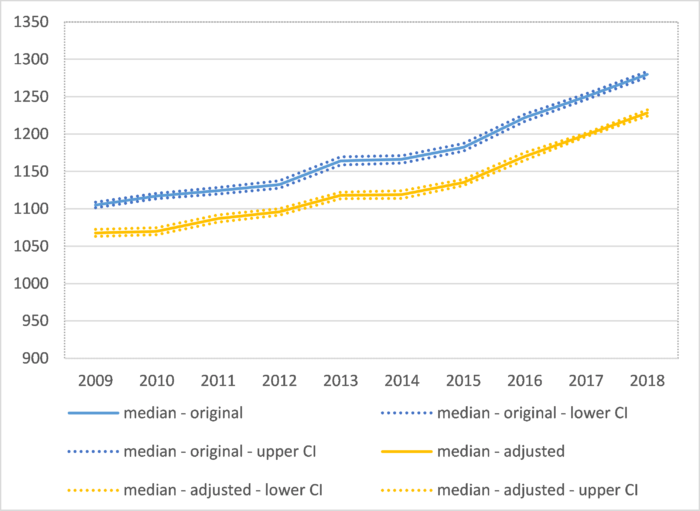Are Some Types of Employers Under-Represented in the Annual Survey of Hours and Earnings?
The UK is fortunate in having many valuable sources of data to inform both research and policymaking. The Annual Survey of Hours and Earnings (ASHE) is one such source. Conducted by the Office for National Statistics (ONS), it provides a critical source of information on the earnings of employees in the UK.

As well as forming the basis for a range of ONS labour market statistics, ASHE is used to inform policymaking and evaluation across a range of UK government bodies, in areas such as the National Minimum/Living Wage and pension provision.
In this interview, our Deputy Director for Public Policy Professor Adrian Pabst talks to Lucy Stokes, Principal Economist, about recent work investigating employer non-response in the ASHE, and its potential consequences for earnings statistics produced from the survey, conducted as part of the ADR-UK funded Wage and Employment Dynamics project.
Why investigate employer non-response in ASHE?
The ASHE is a survey of employee jobs, collecting detailed information about employees’ earnings. While it is a survey of employee jobs, the survey itself is completed by employers. Employers receive the survey questionnaire from ONS and are required to complete and return this for each sampled employee job (employees are selected into the sample on the basis of the last two digits of their National Insurance number).
Completion of the survey is mandatory, but in practice, not all employers respond, or respond quickly enough for their returns to be included in the dataset. We were interested to consider whether there were systematic differences in the types of employers who respond to ASHE. Weights are made available with the ASHE dataset that mean the weighted data are representative of the population of employee jobs in Britain in terms of gender, age, occupation and region. However, if certain types of employers remain over or under-represented, in a way that is not accounted for by the existing survey weights, this could potentially bias estimates derived from the survey, including official statistics.
So are some types of employers over or under-represented in ASHE, and what can be done about this?
To explore this, we compared the profile of employee jobs observed in ASHE with the profile of employment in the Business Structure Database (BSD), which is the best source of information on the population of employee jobs available to us, that also includes information on employer characteristics. Even after applying the standard ASHE weights, we find that employee jobs in larger firms are over-represented in ASHE compared with the profile we would expect based on the BSD, as are employee jobs in the public sector and those among older employers.
Thus certain employer characteristics are associated with response to ASHE in a way that is not accounted for by the existing weights. To address this, the Wage and Employment Dynamics (WED) project team have created an alternative set of weights, which aim to reduce the biases resulting from this non-response among employers. Further details are in our recent methodological paper available here.
We will be making those weights available to other users of the data in due course, through the ONS Secure Research Service. The weights have currently been constructed for the years 2009 to 2018 inclusive.
What are the implications of the alternative weights?
In our paper we explore some illustrative examples of how the adjusted weights affect estimates of hourly pay. When we apply the new weights, we find that estimates of average earnings are lower than under the existing weights (see Figure 1). In 2018, median hourly earnings stood at £12.80 under the existing weights, compared with £12.28 when applying the alternative weights. In 2009, the equivalent figures were £11.05 and £10.68 respectively. However, the trajectory of earnings over time looks broadly similar under both sets of weights. The adjusted weights also have the effect of slightly compressing the wage distribution.
Figure 1: Median hourly pay, 2009-2018, standard ASHE weight and adjusted weight, employees on adult rates, earnings not affected by absence
Where can I find out more and what else should I know about the WED project?
There are many other things happening as part of the WED project! The WED project is linking data from various official surveys and administrative datasets, with the objective of providing new insights into the dynamics of earnings and employment in the UK. The project is led by a team at the University of the West of England, and involves partners from UCL, Bayes Business School, the University of Reading and NIESR.
The ASHE is at the heart of the WED project. Users of ASHE might also be interested in work investigating attrition in ASHE over time, and a new set of longitudinal weights for analysing the data across adjacent years. Another exciting development is the linking of ASHE to the 2011 Census. Recordings of webinars discussing both sets of weights, as well as an introduction to the ASHE-Census linkage, are available on the project website. More is planned for the coming year, as work on linking ASHE to records from HMRC Pay as You Earn (PAYE) and self-assessment data gets underway, so there’s still lots more to come!
You can find out more at the project website: www.wagedynamics.com















